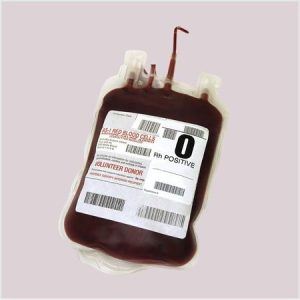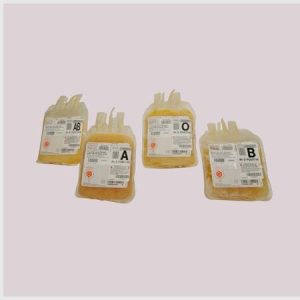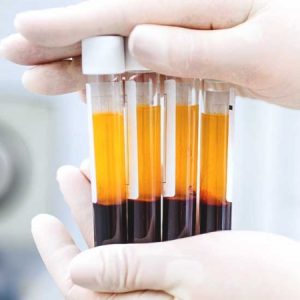our products
When you go to a modern blood bank to get blood, you will almost certainly be asked, “Which Component?” The days of transfusions using only whole blood are long gone. Centrifugation is presently used to separate blood into various types of blood components. To satisfy the needs of the patients, all collected whole blood units are separated into numerous components in our highly advanced component separation facility at the Blood Bank.
Get The Best Price Quote!
PRBC (Packet red blood cell)

- PRBC (Packet red blood cell): Packed red blood cells, also known as PRBCs, RBCs, and packed cells, are a form of blood replacement product used in transfusions.
- PRBCs are extracted from the plasma and other components of whole blood, concentrating them, and suspending them in a smaller volume of saline or another solution.
- A PRBC transfusion is usually done to replace lost blood and increase oxygen-carrying capacity, when a patient has lost a significant amount of blood or has anaemia that is producing significant symptoms.
- PRBCs are extracted from the plasma and other components of whole blood, concentrating them, and suspending them in a smaller volume of saline or another solution.
- Packed Red Cells have a shelf life of 35 days without additive solution and 42 days with additive solution.
WB (Whole blood)

- Whole blood (WB): Whole blood is described as human blood from a routine blood donation that has not been processed or separated into components after being drawn directly from a donor. It is made up of plasma, platelets, white blood cells, and red blood cells in the appropriate proportions.
- Whole blood has a shelf life of up to 35 days, depending on the type of anticoagulant employed.
- Whole blood transfusions are frequently reserved for situations in which a patient requires a complete replacement of all blood components.
- It is used to treat severe bleeding, exchange transfusions, and blood donation.
- However, as component treatment has advanced, where blood components are extracted and transfused separately based on the patient’s specific needs, whole blood transfusions have become less common.
FFP (Fresh Frozen Plasma):FFP is a type of blood product produced from the liquid fraction of whole blood.

- FFP (Fresh Frozen Plasma):Fresh Frozen Plasma (FFP) is a form of blood product made by isolating and freezing plasma, the liquid component of whole blood.
- FFP is often made from donated blood using a method known as plasmapheresis. After collecting the whole blood, the plasma is separated and frozen quickly to preserve its activity. This freezing process keeps the clotting factors and other critical components stable and undamaged.
- It contains clotting factors, proteins, and other components that are necessary for coagulation and maintaining healthy blood flow.
- It is used to treat disorders involving low levels of blood clotting factors (INR more than 1.5) or other blood proteins. It can also be used as a substitute fluid in plasma exchange.
- It can be stored for up to 12 months at -40°C or below
RDP(PRC)(Random donor platelet)

- RDP(PRC)(Random donor platelet): Platelets are derived in extremely small quantities from whole blood. In most circumstances, this is insufficient to cover the needs of a single patient.
- It is important to collect blood from a large number of donors and to combine the platelets acquired from each donor.
- Platelets obtained from whole blood in normal blood donations are hence referred to as Random Donor Platelets (RDPs). “Pooled Platelets” is another name for them.
- Platelets have a 5-day shelf life.
PRP

- PRP( platelet-rich plasma): PRP is a platelet unit that is prepared from a single blood unit (350 ml/450 ml).
- The blood is processed in a centrifuge to separate it into plasma and platelets, which are then concentrated and turned into platelet-rich plasma (PRP).
- It can be either in form of platelet-rich plasma-platelet concentrate (PRP-PC), buffy coat-reduced platelet concentrate (BC-PC) or platelet-rich plasma (PRP).
- platelet-rich plasma have a 5-day shelf life.
SDP/Plasmapherisis

- SDP/PLASMAPHERISIS:In compared to frozen plasma, solvent detergent-treated plasma (SDP) is associated with decreased rates of allergic reaction, transfusion-related lung injury, and virus transmission.
- Plasmapheresis is a therapeutic intervention that involves extracorporeal removal, return, or exchange of blood plasma or components.
- SDP is practically cell free, and contains significantly lower residual platelet concentrations and negligible amounts of microparticles due to its manufacturing process
- SDP has a shelf life of 5 days
CRYO(Cryoprecipitate)

- Cryoprecipitated Antihemophilic Factor, or cryo, is a component of plasma, the liquid portion of our blood.
- Cryo is high in coagulation factors, which are proteins that help to slow or stop bleeding and hence prevent blood loss.
- Cryo is created using donated plasma. The plasma is frozen first, then slowly thawed. Cryo is the insoluble fraction of the plasma that remains after the liquid portion drains away.
- The precipitate is collected and blended with additional donors’ contributions until it reaches a sufficient volume for transfusion. It has a storage life of up to a year.
LRBC (Leukodepleted Packed Red Blood Cells)

- LRBC (Leukodepleted Packed Red Blood Cells):Leukocytes in allogeneic packed red blood cells (PRBC) produce certain adverse effects associated with blood transfusion.
- Leukoreduction is a procedure that reduces the number of leukocytes in blood products in order to minimise infections and death in patients undergoing major cardiovascular surgery.
- In patients having any form of surgery, leukodepleted PRBC may be used to prevent transfusion-related acute lung injury (TRALI) or to reduce mortality and infectious or noninfectious sequelae.

